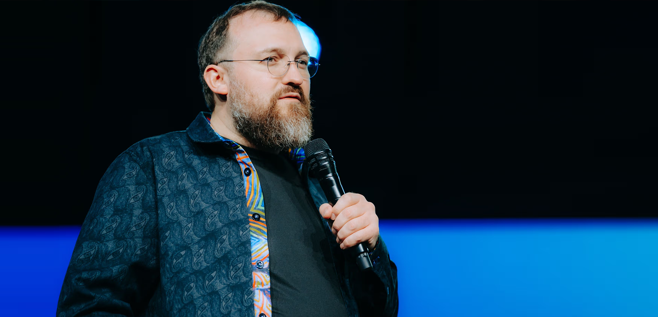Published 18 Aug 2025
Charles Hoskinson: From Ethereum Cofounder to Cardano Visionary

Charles Hoskinson is a mathematician-turned-entrepreneur who has become one of the most influential figures in cryptocurrency. In 2013, he made the bold decision to quit a stable consulting job to focus on Bitcoin education – a move his family thought was “crazy”, but one he felt he had “all figured out”. Fast forward to today, and Hoskinson’s leap of faith has been vindicated.
He is best known as a co-founder of Ethereum and the founder of Cardano, and he has helped shape the blockchain industry through visionary leadership, technical innovation, and a commitment to education and governance. This article explores Hoskinson’s journey – from his early life and Ethereum days to the creation of Cardano – highlighting the milestones, vision, and positive impact of this crypto pioneer.

Early Life, Education, and Early Influences
Born in 1987 in Hawaii to a family of doctors, Charles Hoskinson seemed destined for a traditional career in medicine. Instead, he gravitated toward mathematics and computer science from a young age. He attended Metropolitan State University of Denver and the University of Colorado Boulder to study math, though he ultimately left academia without completing a degree.
During his college years, Hoskinson developed a deep interest in monetary policy and Austrian economics, influenced by libertarian ideas that question the stability of fiat currency. In 2008, he even joined Congressman Ron Paul’s presidential campaign, attracted by Paul’s libertarian views on economics. This interest in alternative finance set the stage for Hoskinson’s entry into the nascent world of cryptocurrency.
By 2013, the emergence of Bitcoin had captured Hoskinson’s imagination as a potential solution to some of the problems of traditional finance. That year, he became the founding chairman of the Bitcoin Foundation’s education committee and launched an online initiative called The Bitcoin Education Project.
Through this project – an online school offering free, peer-reviewed courses on Bitcoin and blockchain – Hoskinson aimed to demystify cryptocurrency and bring a million new users into the crypto space. “My parents thought I was crazy. Everybody thought I was crazy,” Hoskinson later recalled of his decision to go “all in” on crypto, “But I said, no, no, I got it all figured out.”This conviction and willingness to defy the skeptics would become a hallmark of his career.
Co-Founding Ethereum and a Parting of Ways
Hoskinson’s deep dive into crypto education soon led to a fateful encounter with a project that would revolutionize the industry: Ethereum. In late 2013, Hoskinson was introduced to Ethereum’s whitepaper by fellow crypto enthusiast Anthony Di Iorio, and he already knew Ethereum’s author, Vitalik Buterin, through his Bitcoin education work. Enthusiastic about the idea of a programmable blockchain, Hoskinson joined the small founding team of Ethereum and even briefly served as Ethereum’s first CEO.
He was among the five original Ethereum cofounders (alongside Buterin and others) who met in person at the North American Bitcoin Conference in Miami in January 2014 – a gathering now remembered as Ethereum’s genesis moment.
Hoskinson played a key role in Ethereum’s early planning. He helped design Ethereum’s initial coin offering (ICO) and advocated establishing the Ethereum Foundation in Switzerland as a legal entity. However, as Ethereum’s launch drew near, fundamental disagreements emerged within the team. The dispute centered on Ethereum’s direction: Buterin envisioned Ethereum as a non-profit, open-source platform governed by a foundation, whereas Hoskinson argued for a for-profit model that could take on venture capital investment. The clash in vision culminated in what Hoskinson later described as “a boardroom brawl”.
In June 2014, the founders voted to follow Buterin’s nonprofit approach, and Hoskinson was asked to leave the project. This high-profile parting of ways was a pivotal moment for Hoskinson. While Ethereum went on to become a global success, Hoskinson walked away before the ICO – forfeiting a potential fortune in Ether – but also freeing himself to pursue a different path.
Despite the abrupt exit, Hoskinson’s stint at Ethereum cemented his reputation as a talented blockchain visionary. It also taught him valuable lessons. He later reflected that the experience revealed a “governance crisis” in blockchain projects – the challenge of making collective decisions in decentralized teams. This realization would inform his approach to future projects.
Hoskinson took a six-month sabbatical after leaving Ethereum, briefly contemplating a return to academia, before inspiration struck again. One of his Ethereum colleagues, Jeremy Wood, approached him with an idea: start a new company to build better blockchains from the ground up. Revitalized by the possibilities, Hoskinson moved forward to turn this idea into reality.
Founding IOHK and the Birth of Cardano
In late 2014, Charles Hoskinson and Jeremy Wood co-founded Input Output Hong Kong (IOHK) – a blockchain engineering and research company with an ambitious mission. Hoskinson, as CEO, envisioned IOHK as a vehicle to apply rigorous academic research to cryptocurrency development. Rather than chasing quick commercial wins, IOHK would focus on solving the big, long-term challenges of blockchain technology.
Hoskinson deliberately avoided traditional venture capital funding for the new venture, believing that VC money could “run counter to the blockchain’s principles” and lead to outsized control by early investors. Instead, IOHK was funded through cryptocurrency and consulting contracts, aligning with Hoskinson’s ideals of decentralization and community-driven growth.
The centerpiece of IOHK’s work became Cardano, a project that Hoskinson often describes as a third-generation blockchain platform. Cardano’s origin story began with a proposal from a client to create a “Japanese Ethereum” – a new blockchain platform initially targeted at the Japanese market. Development started in 2015, and after two years of quiet building, Cardano launched in September 2017 as a decentralized public blockchain and smart contract platform.
At the time of launch, Cardano was the largest blockchain to use a proof-of-stake (PoS) consensus mechanism, a more energy-efficient alternative to Bitcoin’s proof-of-work. Notably, the project was introduced without a traditional whitepaper. Instead, Hoskinson laid out Cardano’s design in a series of academic papers and forums, reflecting his philosophy that peer-reviewed research should guide the platform’s evolution.
From the outset, Cardano was built with a long-term vision to address the shortcomings of earlier blockchains like Bitcoin and Ethereum. Hoskinson “calls Cardano a ‘third-generation’ smart contract platform and cryptocurrency,” aiming to be “faster and more flexible than Bitcoin, and more scalable and secure than Ethereum”.
The architecture he envisioned for Cardano features multiple layers – a settlement layer for handling ADA cryptocurrency transactions and a separate computation layer for running smart contracts – to enhance scalability and flexibility. Cardano’s development also prioritized formal methods and high assurance code: its core protocol, Ouroboros, became the first PoS algorithm proven secure through peer-reviewed research. By following a scientific approach, Cardano sought to blend cutting-edge innovation with reliability.
A key theme in Cardano’s development has been governance. Chastened by the governance disputes he witnessed at Ethereum, Hoskinson designed Cardano to have a robust on-chain governance system and a treasury to fund future development. “We really do have a governance crisis” in the crypto industry, Hoskinson observed in 2019, calling for more inclusive and transparent decision-making. With Cardano, he has championed the idea that blockchain communities should have mechanisms to vote on proposals and steer their platform’s evolution.
This vision is coming to fruition through Cardano’s Project Catalyst and the forthcoming Voltaire era, which introduce decentralized voting and funding for improvements. Hoskinson’s focus on governance underscores his broader goal: to create a blockchain that can evolve sustainably over decades, guided by its users rather than dictated by any single founder or company.
A Positive Force in the Crypto Space
Over the years, Charles Hoskinson has emerged not only as a technical leader but also as an influential voice in the cryptocurrency community. Through IOHK (now known as Input Output Global) he has assembled teams of researchers and engineers across the world, and he frequently collaborates with academia. IOHK and the Cardano Foundation have sponsored blockchain research labs at universities such as the University of Edinburgh and the University of Wyoming, fostering an exchange of ideas between scholars and industry.
Hoskinson himself donated $20 million to Carnegie Mellon University in 2021 to establish the Hoskinson Center for Formal Mathematics, aiming to advance the use of formal logic and computation in math education. Under his leadership, IOHK also gifted $500,000 to create a blockchain laboratory at the University of Wyoming and $4.5 million to the University of Edinburgh for a research hub on blockchain technology. These acts of philanthropy reflect Hoskinson’s belief in education and innovation – he often notes that rigorous research is at the heart of Cardano’s ethos.
Within the crypto space, Hoskinson is known as an outspoken advocate and educator. He maintains an active YouTube channel with hundreds of thousands of subscribers and regularly hosts live “ask-me-anything” sessions to engage with the Cardano community. On social media platform X (formerly Twitter), where he has a large following, Hoskinson doesn’t shy away from sharing his views on industry news, technological debates, and even crypto politics. “He is an outspoken advocate in the crypto ecosystem,” one profile noted, “frequently voicing his opinion about crypto news, issues, and technology”.
This candid style has earned Hoskinson a devoted fan base, as well as some critics – a dynamic he acknowledges with a bit of humor. “I’m kind of polarizing. People either like me or they hate me,” he has quipped. By and large, however, even skeptics respect the transparency and passion he brings to his work. In an industry often driven by hype, Hoskinson is seen as a thinker who cares deeply about long-term fundamentals.
Perhaps one of Hoskinson’s most significant contributions to the crypto space is his insistence on academic rigor and peer review. While this approach meant Cardano’s features rolled out more slowly than some competitors, it also resulted in high-quality technology. For example, Cardano’s Alonzo upgrade in 2021 introduced smart contracts after extensive testing and formal verification, bringing Cardano into direct competition with Ethereum’s decentralized application ecosystem. By 2023, Cardano had grown to host hundreds of decentralized applications and projects, supported by a vibrant global community.
The platform has consistently ranked among the top cryptocurrencies by market capitalization, a testament to the community’s belief in its long-term vision. Hoskinson’s mantra of “slow and steady wins the race” – inspired by the platform’s namesake, Ada Lovelace, and scientific philosophy – has infused Cardano with a culture of patience and resilience.
Innovation, Education, and Global Impact
Hoskinson’s influence extends beyond the technical realm into the practical applications of blockchain for social impact. He has been a vocal proponent of using blockchain technology to drive financial inclusion and institutional transparency, especially in developing countries. Under his guidance, IOHK has launched projects in Africa and elsewhere that leverage Cardano’s platform for real-world solutions. A notable example is a partnership with Ethiopia’s Ministry of Education to create a blockchain-based national student ID and record system.
The project will provide 5 million Ethiopian students with secure digital IDs and track their academic performance on Cardano’s blockchain. “This initiative is about bringing technology to improve the quality of education,” Ethiopia’s education minister said of the partnership. Hoskinson frequently highlights such efforts as proof of concept that blockchain can deliver tangible value – from empowering unbanked populations to enhancing government services – not just speculative trading.
In addition to his work on blockchain, Hoskinson’s curiosity and entrepreneurial spirit have led him into other cutting-edge fields. He has funded or co-founded ventures exploring genetic engineering and even space exploration. For instance, he supported a project to revive the extinct dire wolf through advanced genetics, and he joined a scientific expedition searching for meteor fragments in the Pacific – pursuits that underscore his wide-ranging appetite for innovation.
While these endeavors might seem far afield from crypto, they spring from the same philosophy: pushing boundaries through science and technology. Hoskinson has remarked that blockchain is just one of many tools to improve the world, and he envisions a future where disciplines intersect – where, say, cryptography meets biotechnology – to solve complex global problems.
Yet, it is in the realm of blockchain governance and education where Hoskinson’s mark is most indelible. He has consistently championed the idea of decentralized governance as a cornerstone for the next generation of crypto platforms. “If it’s truly decentralized, you need a completely different way for people to coordinate,” Hoskinson explained in one interview, emphasizing the need for structures that allow communities to self-govern effectively.
To that end, Cardano’s governance model is breaking new ground with community-elected representatives and on-chain voting to decide the blockchain’s future. At the same time, Hoskinson invests in educating the next wave of blockchain developers. IOHK runs academies and programs (like the Plutus Pioneers course) to teach people Haskell and smart contract development on Cardano, reflecting Hoskinson’s belief that open education will spur adoption and innovation.
Current Endeavors and Leadership in Crypto
As of 2025, Charles Hoskinson continues to serve as CEO of Input Output Global, steering Cardano’s development and evangelizing blockchain technology on the world stage. His leadership style – characterized by openness, intellectual rigor, and a dash of showmanship – has kept Cardano in the spotlight as a project with grand ambitions. In recent years, Hoskinson has taken to testifying before the U.S. Congress and engaging with regulators, advocating for fair and sensible crypto regulations.
He argues that blockchain technology, if properly understood by lawmakers, can be a transformative force for good, and he has positioned himself as a bridge between the crypto community and policymakers. This has further solidified his reputation as a thought leader in the field.
Under Hoskinson’s watch, Cardano is marching through an extensive roadmap of upgrades named after historical figures (Byron, Shelley, Goguen, Basho, Voltaire). Each phase adds new capabilities – from staking (Shelley, 2020) to smart contracts (Goguen/Alonzo, 2021) to scalability improvements (Basho) and decentralized governance (Voltaire, forthcoming). Rather than resting on past achievements, Hoskinson is now guiding Cardano’s evolution with an eye on the next decade.
He recently announced a shift to more agile development processes in order to accelerate Cardano’s pace of innovation, balancing the project’s trademark academic rigor with a need for faster execution. The goal is to ensure Cardano remains competitive in a fast-moving industry without compromising the qualities that distinguish it.
Meanwhile, Charles Hoskinson’s stature in the crypto community remains unmistakably high. Cardano’s community is one of the largest and most engaged in crypto, and Hoskinson’s regular updates and frank dialogues have fostered a strong sense of connection between the project’s leadership and its global base of supporters. He has been recognized as one of the top personalities in crypto – often listed among the industry’s most influential figures – not only because of his technical contributions but also due to his philosophical contributions to what blockchain can and should be.
Hoskinson often emphasizes a long-term vision: he speaks of blockchain technology as a multi-generational endeavor, comparing the current state of crypto to the early days of the internet. In line with that vision, he has laid plans for Cardano’s future that span decades, including handing governance entirely over to the community and ensuring the system can operate sustainably without its founders.
Legacy and Outlook
Maintaining a positive trajectory throughout his career, Charles Hoskinson has turned early skepticism into a legacy of innovation. His biography reads like a microcosm of the crypto industry itself – bold experiments, ideological clashes, exponential growth, and an unwavering belief in the power of decentralized technology. From co-founding Ethereum in his twenties to building Cardano into a top blockchain platform, Hoskinson’s journey underscores a willingness to challenge conventions and learn from each chapter.
He has combined technical prowess with a zeal for learning and teaching, often highlighting that Cardano’s slow, research-driven approach is about “doing it right rather than doing it fast.” This patience appears to be paying off as Cardano steadily advances and finds real-world traction.
In the crypto world, where controversies and hype cycles can dominate headlines, Hoskinson has largely kept the focus on positive development and problem-solving. He consciously steers away from needless drama, choosing instead to engage in substantive debates on protocol design, governance, and the future of finance. While no stranger to criticism, he tends to address it head-on – using facts, figures, and sometimes his trademark wit.
For example, when media outlets proclaimed gloom during market downturns, Hoskinson took to Twitter to remind everyone that “the future is bright” and that institutional capital was on the horizon for crypto. Such optimism, grounded in a broad perspective, has made him a reassuring voice during crypto’s volatile moments.
Looking ahead, Charles Hoskinson’s influence shows no sign of waning. As blockchain technology matures, the principles he champions – rigorous research, inclusive governance, and global accessibility – are increasingly being recognized as crucial to the industry’s long-term success.
Cardano, under his guidance, is poised to tackle challenges like scalability and interoperability while keeping an eye on delivering services (like identity, supply chain tracking, and financial products) to communities that need them most. Hoskinson often notes that we are “just getting started” in unlocking blockchain’s potential. Given his track record, it’s a safe bet that he will continue to be at the forefront of that effort, leading with a blend of idealism and pragmatism.
Charles Hoskinson’s story is far from over, but already it serves as an inspiring example of what a clear vision and dedication to first principles can achieve in crypto space. From his early days educating people about Bitcoin, to the turbulent birth of Ethereum, to the methodical rise of Cardano, he has remained true to a mission of advancing blockchain technology for the betterment of society. In doing so, Hoskinson has earned his place among the top figures in crypto – a visionary with a positive outlook, helping to write the future of decentralized finance one peer-reviewed paper and one block at a time.
Read More




 Get RateX Pro
Get RateX Pro

 06 Jun 2024
06 Jun 2024
